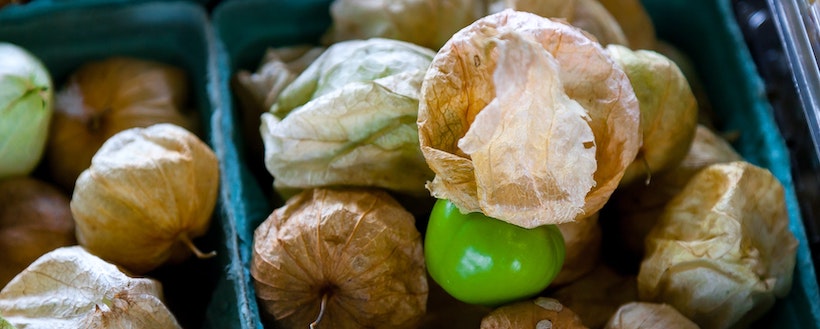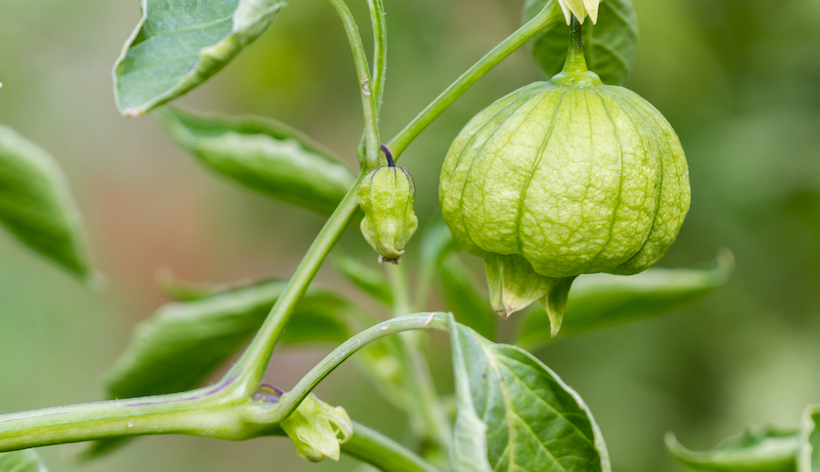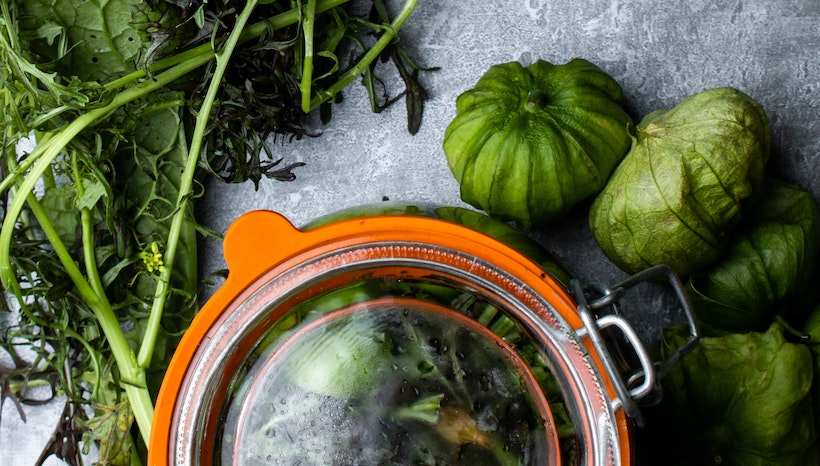The tomatillo, or "little tomato" in Spanish, is a Mexican cuisine staple – and very popular in America. You might have tried this distant relative of the tomato that gives a lovely acidic punch to soups and salsas. Personally, I first ran across them in college in Los Angeles (there aren't many on the East Coast!)
But do you know its history? It's quite the story – it goes way back to the ancient cultures that populated Central America before Europeans arrived. In this post, I'll share what I learned after digging into the history of the tomatillo.

The tomatillo, or husk tomato, is a small fruit in the solanaceous family—commonly known as the nightshades—which grows inside a leafy, papery husk.
It's a distant relative of the tomato and cape gooseberry that also originated in Mesoamerica. It's been an important source of nutrition in Mexico and Guatemala for centuries, but there's a lot more to the story.
A tomatillo is a small semi-annual nightshade that produces small, round green fruit that grows inside the plant's calyx. This fruit of most tomatillo cultivars is green, so some also call it a tomate verde, or green tomato. It can also be yellow when ripe, and some varieties are even greenish-purple.
The husk that covers the tomatillo is also green when it's growing. When it's ripe, the husk turns browner, more paper-like and fragile, and starts opening up. Also, the fruit has a sticky substance covering it that's not dangerous (but you should wash it off before cooking).
Thanks to its expansion to many locations globally, tomatillos are available year-round. However, their primary growing season is the summer. The wild tomatillos of Mexico flower in June, and the fruits ripen through July and into the fall months.
This plant has spread all over Mexico, Guatemala, and the southern United States and was even introduced (successfully) to India and Australia. It grows well in different altitudes, from sea level to up to 1.6 miles high in the Valley of Mexico.
The plant is also easy to grow in your garden, and it's good for displacing weeds, but it does need some space for growing. It grows in similar, warm conditions as the tomato (as expected, ha), but you should plant it around two weeks later than tomato seeds in spring.
You can harvest tomatillos when the fruit is firm, green, and big enough to fill the husk.
Like most fruits and vegetables, the tomatillo contains a mix of vitamins and minerals necessary for a healthy life. As a plant, they don't have any sodium or cholesterol.
The tomatillo is a good source of vitamins A, C and K, and niacin, or B3.
However, since tomatillos are usually cooked before eating, they'll likely lose some of their vitamins. Water-soluble vitamins such as Vitamin C are especially sensitive to boiling, so roasting or steaming your tomatillos might be a good idea if you're looking for a dose of Vitamin C.
The fruit also has some iron and potassium, and even a bit of calcium. It also has some other favorable compounds, including flavonoids and choline, which can reduce systemic inflammation and is important to the nervous system.
The tomatillo's macronutrient profile is:
It's not necessarily easy (or pleasant) to bite into a fresh, raw tomatillo. A tomatillo's taste is acid and citrusy, and its texture is much drier than its cousin, the tomato. Cooking the tomatillo will help bring out the sugars and make it more palatable, but it remains tangy even when cooked.
The salsa verde, or green salsa, is probably the most common use of the tomatillo today. Salsa verde is made by blending cooked tomatillos, spices, and chiles in a blender or food processor. Some onion and garlic will make the salsa extra flavorful, as will roasting the tomatoes in the oven.
You can also mix tomatillos or salsa verde in a soup, or add it to your guacamole or gazpacho. Just remember that the tomatillo is far easier on your palate when it's cooked. But let me know if you eat them raw!

The tomatillo is a prehistoric plant that has been around a lot longer than us humans, but we're the ones responsible for spreading it across the globe. Humans have also applied selective pressure, making them more suitable for farming (and eating).
Researchers dated a native tomatillo plant fossil to a whopping 52 million years ago. Surprisingly, this plant was found in Patagonia, at the very southern tip of Argentina. During human civilization's timeline, the tomatillo plant first appeared further north, in Mesoamerica.
The name tomatillo comes from the word tomatl in Nahuatl—the language of the Aztecs (and the root of the tomato's name as well). The original inhabitants of the Americas cultivated the tomatillo for centuries, from around 800 BCE. The plant was also an important food source for the Mayans.
Archeologists have found remains of the tomatillo in excavations in the Valley of Tehuacán in Mexico (found between Mexico City and Oacaca) . It was even more common than the tomato, thanks to being more resistant to rotting and heat.
The first people to introduce the common red tomato to Southern Europe were most likely Spanish conquistadors. Some researchers believe Hernán Cortés himself brought tomato seeds back from his travels – but read our history of the tomato article and you be the judge.
The word for the red tomato in Central Mexico today is jitomate, which comes from the Nahuatl xitomatl. It's likely that Spaniards confused this word with tomatl and started referring to the green vegetable merely as a small tomato.
The red tomato variety slowly became popular in Europe, likely thanks to being so much sweeter, colorful, and easier to eat. The name tomatl stuck to this plant instead of its original owner, and the tomatillo has been the linguistic little sister of the tomato ever since.
In Europe, the tomato originally had a bad reputation as a poisonous plant. Because of its high acidity that made lead leach from aristocrats' pewter plates (conveniently sparing lower classes who ate off wood), the tomato was even referred to as the "poison apple" in Europe. The fear finally disappeared in the 19th century, and tomatoes have been a staple in our kitchens ever since.
After the arrival of Europeans, the tomatillo home saw its large-scale cultivation drop massively. However, local populations still consumed the fruit, especially in rural areas.
In the 1980s, the crop became industrialized in Mexico, with 80 percent of the production exported to the United States. Local consumption in Mexico took care of the remaining portion. There are other large growers in California.
In the 1950s, the plant was also introduced to India, and local production started in the northern region of Rajasthan. Tomatillo lends a tangy touch to local Indian dishes, including curries, chutneys, and dal-type stews.
The plant grows well in many different, warm locations, and today has successfully taken root in Australia and South Africa.
It's almost too hardy – it even gained the status of a weed in some agricultural lands in Kenya in 1967. And, yes, in some areas of the United States, it's considered an invasive species.
Even with its fast growth, the tomatillo is still something of a niche product, mostly incorporated in Mexican or Mexican-inspired dishes. It represents only a small percentage of tomato sales in the US today, but its share is slowly growing as people (like my family) are more interested in healthy, varied diets and come around to the tomatillo.
And, given the popularity of tomatoes as by far the world's most common vegetable crop, it's quite a sizable market. The world produced around 340 billion pounds of tomatoes in 2014, so even a small slice of the big pie is massive.

Pretty interesting, right?
Though we often associate tomatillos with their sweeter, larger (redder) cousin the tomato, they've got a fascinating story in their own right. And as the world turns to healthier eating habits and discovers more fruits and veggies, you know tomatillo is on the menu. Hope this was a fun look you'll remember the next time you pick up half a dozen at the market!